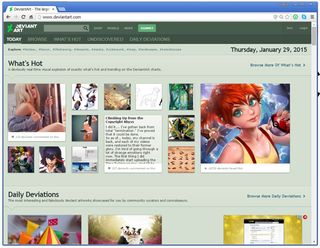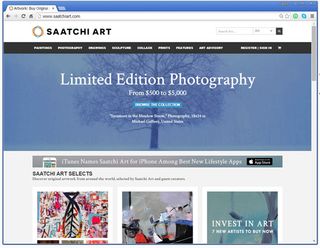Moving from digital to traditional art
Creative director Lance Evans investigates how a commercial artist can create new markets and income.
An ideal compromise for many artists today is to seek representation by an established and curated online gallery. By comparison to the open market sites already discussed, a gallery offers artists a sales team who work to convert eyeballs into sales, and offers buyers the comfort of curatorial support. Many gallery owners claim to be having great success selling online. Two such well known galleries are UGallery.com, and Art.com, each of which cater to very different segments of the Fine Art market.
UGallery.com was a pioneer in the "real art gallery, just online" arena that began ten years ago. While they focus on the mid-tier original art market of paintings and hand made prints, they now offer digital giclée prints as well. This is an ideal medium for artists producing computer-based work.

Founder and Director Alex Farkus told us they sell original art priced from $200 to $20,000. This is significantly higher than the prices seen on the non-curated sites. It underscores the financial advantages of working with an established gallery. When it comes to artists, Alex stated "We are continuously seeking new artists." And that, "We look for new work that we believe will be of the greatest interest to our clientele. We've found that dark or explicit content is always difficult sell. Yet we always want unique – we've all seen enough butterfly and Eiffel Tower photographs for a lifetime!"
Alex emphasizes, "We try not to place too much importance on education or background. There are so many talented artists out there just looking to get their start or transition to a new art form. We love working with these types of artists."

By comparison to the hand-holding one might get at a smaller gallery, Art.com is a market leader that sells huge numbers of affordable art prints, most topping out at a few hundred dollars. Peter Lindsay is the Senior Buyer at Art.com. "We try to retail these products at an affordable range that are friendly to the more casual art enthusiast. We don't want that initial discovery process to be cost prohibitive."
When asked about working with the independent artist, Lindsay said that: "While the percentage of independent artists in our catalog is small, these direct artist relationships are an important pillar of our brand. So we will often emphasize those products heavily throughout our store."

Cassie Marie Edwards is one artist that has found success on Art.com, splitting her professional time half as a fine artist, and half teaching art and design at Dakota State University.
Get the Creative Bloq Newsletter
Daily design news, reviews, how-tos and more, as picked by the editors.
"I was contacted by Art.com after they had seen some of my paintings. We partnered to release a group of prints as part of their 'Meet the Artists' campaign. It wasn't a huge time investment for me to start selling on Art.com. We worked together and were ready to go fairly quickly. One of the perks of working with them is that they handle a lot of the less fun parts of selling prints online, freeing up more of my time to create."

Lindsay expands on these relationships. "When we purchase from artists it's usually because they're offering something unique from their own hand, like signed limited editions, or some type of hand-pulled products such as screen or letterpress prints. Much more often though we work with the artist to create a portfolio that we print on demand."
"Commercial or advertising artist... those categories aren't especially relevant to us. Some artists we work with are more strongly grounded in fine arts and others more in commercial art. Increasingly we see that there's much more fluidity, artists participating in both markets.
We asked Lindsay to summarize what gets an artist featured on the Art.com homepage? "Great work and good timing. It has to fit into some trend in art or design. For any artists out there that are interested in selling your work on Art.com, please send us a message at merchandising@art.com and tell us a little about you and your art."
Words: Lance Evans
Main image: Ajo Galván
Lance Evans is creative director of Graphlink Media.
View a sampler of fantastic 146-page magazine Practical Painter below:
Don't miss out. Pre-order now!

Thank you for reading 5 articles this month* Join now for unlimited access
Enjoy your first month for just £1 / $1 / €1
*Read 5 free articles per month without a subscription

Join now for unlimited access
Try first month for just £1 / $1 / €1
The Creative Bloq team is made up of a group of design fans, and has changed and evolved since Creative Bloq began back in 2012. The current website team consists of eight full-time members of staff: Editor Georgia Coggan, Deputy Editor Rosie Hilder, Ecommerce Editor Beren Neale, Senior News Editor Daniel Piper, Editor, Digital Art and 3D Ian Dean, Tech Reviews Editor Erlingur Einarsson and Ecommerce Writer Beth Nicholls and Staff Writer Natalie Fear, as well as a roster of freelancers from around the world. The 3D World and ImagineFX magazine teams also pitch in, ensuring that content from 3D World and ImagineFX is represented on Creative Bloq.
